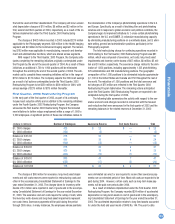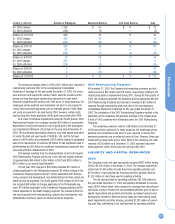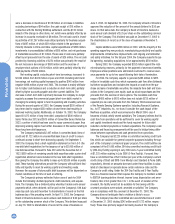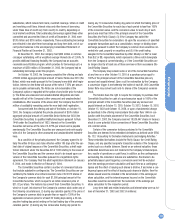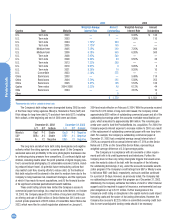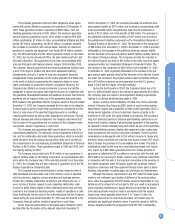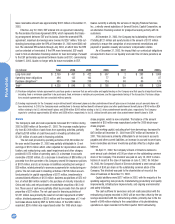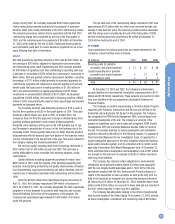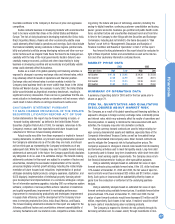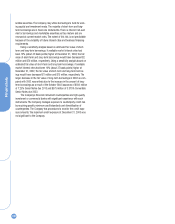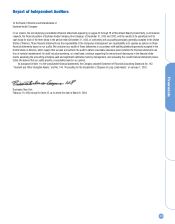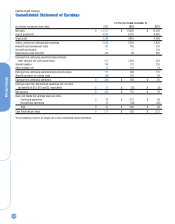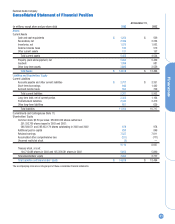Kodak 2003 Annual Report Download - page 35
Download and view the complete annual report
Please find page 35 of the 2003 Kodak annual report below. You can navigate through the pages in the report by either clicking on the pages listed below, or by using the keyword search tool below to find specific information within the annual report.
Financials
35
any VIEs which it had created or obtained an interest in after January 31,
2003.
In April 2003, the FASB issued SFAS No. 149, “Amendment of
Statement 133 on Derivative Instruments and Hedging Activities.” SFAS
No. 149 amends and clarifies the accounting for derivative instruments,
including certain derivative instruments embedded in other contracts, and
for hedging activities under SFAS No. 133, “Accounting for Derivative
Instruments and Hedging Activities.” SFAS No. 149 is generally effective
for contracts entered into or modified after June 30, 2003 and for hedging
relationships designated after June 30, 2003. The adoption of SFAS No.
149 did not have any impact on the Company’s financial position, results
of operations or cash flows.
In May 2003, the FASB issued SFAS No. 150, “Accounting for Certain
Financial Instruments with Characteristics of Both Liabilities and Equity.”
SFAS No. 150 requires that certain financial instruments, which under pre-
vious guidance were recorded as equity, be recorded as liabilities. The
financial instruments affected include mandatorily redeemable stock, cer-
tain financial instruments that require or may require the issuer to buy
back some of its shares in exchange for cash or other assets, and certain
obligations that can be settled with shares of stock. The Company adopted
SFAS No. 150 on June 1, 2003. The adoption of this statement did not
have any effect on the Company’s financial position, results of operations
or cash flows.
EITF Issue No. 03-05, “Applicability of AICPA Statement of Position
(SOP) 97-2 to Non-Software Deliverables in an Arrangement Containing
More-Than-Incidental Software,” effective September 30, 2003, states
that, only software and software-related elements are in the scope of SOP
97-2. The adoption of EITF No. 03-05 did not have a material impact on
the Company’s financial position, results of operations or cash flows.
In December 2003, the FASB issued a revision of SFAS No. 132,
“Employers’ Disclosures about Pensions and Other Postretirement
Benefits.” SFAS No. 132 requires that companies disclose more informa-
tion about plan assets, benefit obligations, cash flows, benefit costs and
other relevant information. Companies are required to disclose plan assets
by category and a description of investment policies, strategies and target
allocation percentages for these asset categories. Cash flows must include
projections of future benefit payments, and an estimate of contributions to
be made in the next year to fund pension and other postretirement benefit
plans. In addition, companies are required to disclose various elements of
pension and other postretirement benefit costs on a quarterly basis.
Certain provisions of SFAS No. 132 were effective and were implemented
as of and for the year ended December 31, 2003. Certain of the other pro-
visions will be effective for quarterly and annual periods beginning after
December 15, 2003. Refer to Note 17, “Retirement Plans,” for these new
disclosures.
In January 2004, the FASB issued FASB Staff Position (FSP) No. 106-
1, “Accounting and Disclosure Requirements Related to the Medicare
Prescription Drug, Improvement and Modernization Act of 2003.” FSP No.
106-1 allows the sponsor of a postretirement health care plan that pro-
vides a prescription drug benefit to make a one-time election to defer
accounting for the effects of the Medicare Prescription Drug, Improvement
and Modernization Act of 2003 (the Act). The Act, which was signed into
law in December 2003, introduces a prescription drug benefit under
Medicare as well as a federal subsidy to sponsors of retiree health care
benefit plans that provide a benefit that is at least actuarially equivalent to
Medicare. The guidance in this FSP is effective for interim or annual finan-
cial statements of fiscal years ending after December 7, 2003. In accor-
dance with FSP No. 106-1, the Company has elected to defer accounting
for the effects of the Act. Refer to Note 18, “Other Postretirement
Benefits,” for disclosures required by FSP No. 106-1.
RISK FACTORS
Set forth below and elsewhere in this report and in other documents that
the Company files with the Securities and Exchange Commission are risks
and uncertainties that could cause the actual future results of the
Company to differ from those expressed or implied in the forward-looking
statements contained in this document and other public statements the
Company makes. Additionally, because of the following risks and uncer-
tainties, as well as other variables affecting our operating results, the
Company’s past financial performance should not be considered an indi-
cator of future performance and investors should not use historical trends
to anticipate results or trends in future periods.
Kodak recently announced plans to emphasize digital technology to
expand into a range of commercial businesses in order to create a more
balanced and diversified business portfolio while accelerating the imple-
mentation of its existing digital product strategies in the consumer mar-
kets. Kodak expects to incur restructuring charges in relation to these ini-
tiatives. The expected benefits from these initiatives are subject to many
estimates and assumptions, including assumptions regarding: (1) the
amount and timing of cost savings and cash flow that Kodak can achieve
from its traditional consumer film and paper businesses; (2) the speed at
which consumer transition from traditional photography to digital photog-
raphy occurs; (3) Kodak’s ability to develop new digital businesses in its
commercial, consumer and health markets; (4) Kodak’s ability to identify
and complete compatible strategic acquisitions consistent with its growth
timeline; and (5) the costs and timing of activities undertaken in connec-
tion with these initiatives. In addition, these estimates and assumptions
are subject to significant economic, competitive and other uncertainties
that are beyond Kodak’s control. If these assumptions are not realized, or
if other unforeseen events occur, Kodak’s results of operations could be
adversely affected, as it may not be able to grow its business, and its abil-
ity to compete could be negatively affected.
Unanticipated delays in implementing certain product strategies
(including digital products, category expansion, digitization, and OLED dis-
plays) could adversely affect Kodak’s revenues. Kodak’s ability to success-
fully transition its existing products and develop and deploy new products
requires that Kodak make accurate predictions of the product develop-
ment schedule as well as volumes, product mix, customer demand, sales
channels and configuration. The process of developing new products and
services is complex and often uncertain due to the frequent introduction of
new products that offer improved performance and pricing. Kodak may
anticipate demand and perceived market acceptance that differs from the
product’s realizable customer demand and revenue stream. Further, in the
face of intense industry competition, any delay in the development, pro-
duction or marketing of a new product could decrease any advantage
Kodak may have to be the first or among the first to market. Kodak’s fail-
ure to carry out a product rollout in the time frame anticipated and in the
quantities appropriate to customer demand, or at all, could adversely


